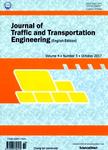Evaluation of pedestrian mid-block road crossing behaviour using artificial neural network
Evaluation of pedestrian mid-block road crossing behaviour using artificial neural network作者机构:Department of Civil EngineeringIndian Institute of Technology Bombay
出 版 物:《Journal of Traffic and Transportation Engineering(English Edition)》 (交通运输工程学报(英文版))
年 卷 期:2014年第1卷第2期
页 面:111-119页
学科分类:1201[管理学-管理科学与工程(可授管理学、工学学位)] 08[工学] 082303[工学-交通运输规划与管理] 0813[工学-建筑学] 0814[工学-土木工程] 082302[工学-交通信息工程及控制] 0823[工学-交通运输工程]
主 题:pedestrian mid-block artificial neural network rolling gap gap acceptance behavior
摘 要:Pedestrians usually cross the road at mid-block locations in India because of the ease and convenience to reach their destination as compared to intersection locations. It is important to evaluate the pedestrian gap acceptance behavior at mid-block locations because of inadequate vehicular gaps un- der mixed traffic condition, which translates into the pedestrian road crossing behavior. The present study examines the pedestrian gap acceptance behaviour by employing an artificial neural network (ANN) model for understanding the decision making process of pedestrians, i. e. , acceptance or rejec- tion of vehicular gaps at a mid-block location. From the results it has been found that the pedestrian rolling gap, frequency of attempt, vehicular gap size, pedestrian speed change condition and vehicle speed have major role in pedestrian gap acceptance. These results can lead to a better design of pedestrian crossing facilities where adequate gaps are not available in vehicular flow at mid-block crosswalk locations.



